 One of the
things I like most about being a geologist is meeting an amazingly vast
diversity of people. Every one of the people on this page has a
life - just like you and I do - with hopes, dreams, memories, love,
embarassments, fears, ... every feeling
that you and I feel! I can't even hope to do the people in these
photos justice in describing them, so I'm just going to post their
photos and let you try to imagine the complexity of their lives.
One of the
things I like most about being a geologist is meeting an amazingly vast
diversity of people. Every one of the people on this page has a
life - just like you and I do - with hopes, dreams, memories, love,
embarassments, fears, ... every feeling
that you and I feel! I can't even hope to do the people in these
photos justice in describing them, so I'm just going to post their
photos and let you try to imagine the complexity of their lives.
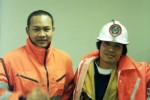 Lasito was
assigned to work with me while mapping underground. I'd only very
rarely ever mapped with someone (I'd always mapped alone), so I was
worried that company would slow me down. I'm sure he thought
something along the lines of, "Of all the luck! I have work to do
- I can't just squander my time away babysitting some
bulai!" ("Bulai" is the Indonesian equivalent of gringo.) In very short order
we became friends, however, and Lasito remains to this day one of the
people in this world I respect very highly.
Lasito was
assigned to work with me while mapping underground. I'd only very
rarely ever mapped with someone (I'd always mapped alone), so I was
worried that company would slow me down. I'm sure he thought
something along the lines of, "Of all the luck! I have work to do
- I can't just squander my time away babysitting some
bulai!" ("Bulai" is the Indonesian equivalent of gringo.) In very short order
we became friends, however, and Lasito remains to this day one of the
people in this world I respect very highly.
 Utu
(left) was the core shed manager - he made sure things got done
there. He had a fancy aluminum hard hat with impressions of
mining scenes worked into the metal. It was one of a kind!
Utu
(left) was the core shed manager - he made sure things got done
there. He had a fancy aluminum hard hat with impressions of
mining scenes worked into the metal. It was one of a kind!These guys (right) are the draftsmen in the engineering building by the mill. They were nice guys who were usually too busy to help - very suspicious behavior for such a group!
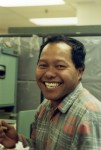
 Joko
(right) was a sort of helper for underground work trusted with sampling
the walls of the tunnels, delivering things to various places,
etc. I think that he always has a smile on his face - a good guy!
Joko
(right) was a sort of helper for underground work trusted with sampling
the walls of the tunnels, delivering things to various places,
etc. I think that he always has a smile on his face - a good guy!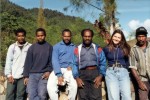
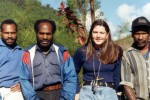 Stacie
really took advantage of the opportunity to get to know people from all
of the different cultures. We kiddingly called her "ratu Stacie"
(queen Stacie) because she seem to get along with everyone! These
guys are some of the Papuans who worked at the core shed in the high
country.
Stacie
really took advantage of the opportunity to get to know people from all
of the different cultures. We kiddingly called her "ratu Stacie"
(queen Stacie) because she seem to get along with everyone! These
guys are some of the Papuans who worked at the core shed in the high
country.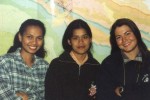
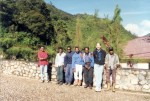 Three
beautiful women! Lana (on the left) was a student working for the
summer. I think she's now working in the petroleum
industry. Effie (center) was the office secretary - very quiet
and traditional young woman. That's Stacie on the right, of
course.
Three
beautiful women! Lana (on the left) was a student working for the
summer. I think she's now working in the petroleum
industry. Effie (center) was the office secretary - very quiet
and traditional young woman. That's Stacie on the right, of
course.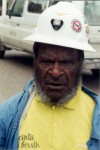
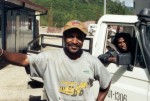 These are
some of the guys
that worked at the core shed at the exploration office in
Tembagapura. They used to sing a little song in what I suppose
was the amungme language, but I couldn't tell for sure. I learned
the song, but only in the way a mima bird learns songs.
These are
some of the guys
that worked at the core shed at the exploration office in
Tembagapura. They used to sing a little song in what I suppose
was the amungme language, but I couldn't tell for sure. I learned
the song, but only in the way a mima bird learns songs. 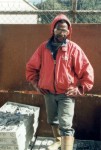
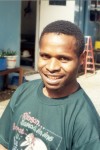 Most of
the Papuans had names that end in "us," such as Pranus, Demianus,
Julianus, etc. I suppose that is an impression made from the
times that Indonesia was a Dutch colony. That's Demius on the
right - mister cool!
Most of
the Papuans had names that end in "us," such as Pranus, Demianus,
Julianus, etc. I suppose that is an impression made from the
times that Indonesia was a Dutch colony. That's Demius on the
right - mister cool!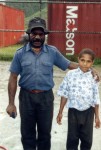
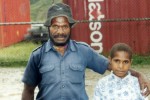 Julianus
was a hard worker - he was a carpenter of sorts who made our sample
boxes. His son came to work to visit him one day and Julianus
radiated pride. His son goes to school (that's why he's so
dressed up). I ran into Julianus one day at the non-expat market
and he was stressed. He needed to buy his son a blank notebook
for school and he didn't have any money with him. Stacie bought
him a notebook and he was amazingly grateful.
Julianus
was a hard worker - he was a carpenter of sorts who made our sample
boxes. His son came to work to visit him one day and Julianus
radiated pride. His son goes to school (that's why he's so
dressed up). I ran into Julianus one day at the non-expat market
and he was stressed. He needed to buy his son a blank notebook
for school and he didn't have any money with him. Stacie bought
him a notebook and he was amazingly grateful. 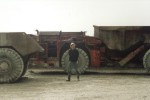
 I spent a
fair amount of time studying drill core at the "Mile 66 Core
Shed." The company assigned a couple guys to help me move the
core boxes around. I was lugging rocks with one of the fellows,
when I noticed the second guy had disappeared for quite a while -
longer than a reasonable bathroom break. I looked over at the guy
who was still with me and asked using body language where the guy
went. He didn't know. A few minutes later, we heard a yelp,
so the remaining worker went to investigate. After another 10
minutes, when he didn't return, I went looking for them. I found
them sitting on a 5-foot (1.5 meter) high pile of old time cards stored
in a big shipping container, humming away happily as they removed the
rubber bands they'd make into jewelry. The security guard was
right there with them, collecting rubber bands.
I spent a
fair amount of time studying drill core at the "Mile 66 Core
Shed." The company assigned a couple guys to help me move the
core boxes around. I was lugging rocks with one of the fellows,
when I noticed the second guy had disappeared for quite a while -
longer than a reasonable bathroom break. I looked over at the guy
who was still with me and asked using body language where the guy
went. He didn't know. A few minutes later, we heard a yelp,
so the remaining worker went to investigate. After another 10
minutes, when he didn't return, I went looking for them. I found
them sitting on a 5-foot (1.5 meter) high pile of old time cards stored
in a big shipping container, humming away happily as they removed the
rubber bands they'd make into jewelry. The security guard was
right there with them, collecting rubber bands. 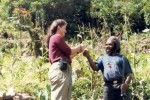
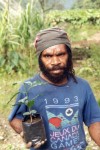 Stacie was
always amazingly great about getting in there and mixing with the
locals. I really think she ought to get a job with National
Geographic or Smithsonian if she ever tires of geology. She liked
to try doing what she saw indigenous people doing because experience is
better than just watching.
Stacie was
always amazingly great about getting in there and mixing with the
locals. I really think she ought to get a job with National
Geographic or Smithsonian if she ever tires of geology. She liked
to try doing what she saw indigenous people doing because experience is
better than just watching.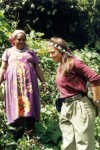
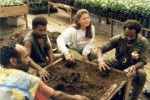
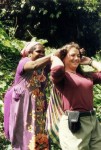 Here, she's
sifting topsoil at the nursery and trying on one of the carrying bags
that the Papuans use instead of backpacks (they have a band that wraps
around your forehead instead of straps for your shoulders).
Here, she's
sifting topsoil at the nursery and trying on one of the carrying bags
that the Papuans use instead of backpacks (they have a band that wraps
around your forehead instead of straps for your shoulders).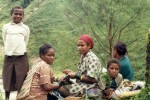 The women
on the left are a group who were waiting for the bus.
The women
on the left are a group who were waiting for the bus.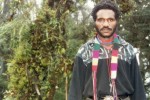 Pranus
here came out of the dripping jungle while I was logging core alone one
day. He was carrying a machete and speaks no English. He turned
out to be a nice fellow who was just out looking for kuskus (tree
kangaroos).
Pranus
here came out of the dripping jungle while I was logging core alone one
day. He was carrying a machete and speaks no English. He turned
out to be a nice fellow who was just out looking for kuskus (tree
kangaroos).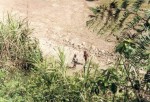 Some
Papuans walking to the mine
Some
Papuans walking to the mine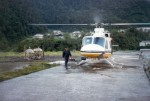
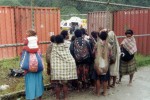
 Freeport
Indonesia provides free helicopter transport for Papuan tribespeople in
order to facilitate commerce between villages. Considering the
cost of helicopter time, this is incredibly generous. Travel
between tribal villages can be days by foot. Flying also helps
because people don't have to lug their bags through the extraordinarily
steep and dense jungle.
Freeport
Indonesia provides free helicopter transport for Papuan tribespeople in
order to facilitate commerce between villages. Considering the
cost of helicopter time, this is incredibly generous. Travel
between tribal villages can be days by foot. Flying also helps
because people don't have to lug their bags through the extraordinarily
steep and dense jungle. 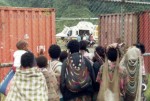
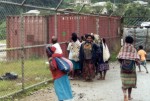
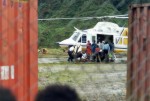 On the
other hand, if the mine ever closes (which could be 100 years in the
future - who knows?), then these people could be stuck with a
dependency on a service that someday stops. Building nice
foot-roads through the jungle will be incredibly difficult, so I don't
know what the answer is for this one! These people are all
waiting for a ride to their villages on the helicopter.
On the
other hand, if the mine ever closes (which could be 100 years in the
future - who knows?), then these people could be stuck with a
dependency on a service that someday stops. Building nice
foot-roads through the jungle will be incredibly difficult, so I don't
know what the answer is for this one! These people are all
waiting for a ride to their villages on the helicopter. 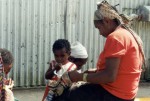
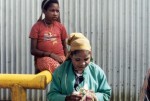
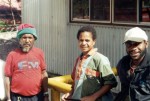
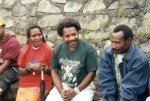
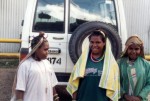
People waiting for the helicopter
